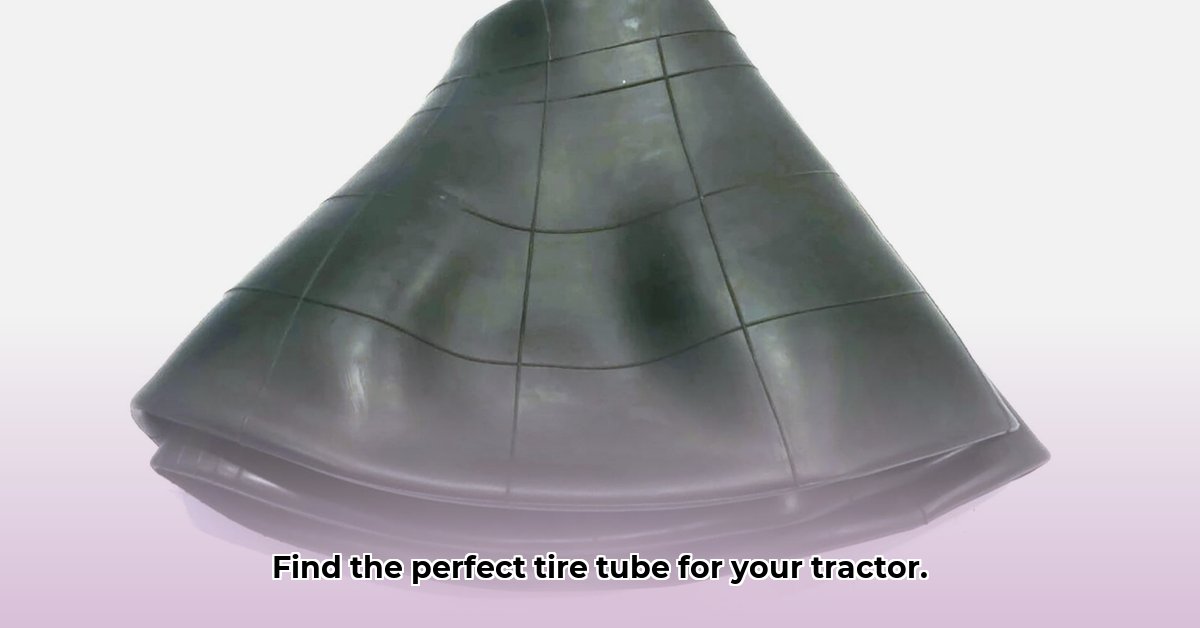
Downtime on the farm is costly. A flat tire can significantly impact your productivity, leading to lost time and revenue. Ensuring you have the correct 11.2-24 tractor tire tube is crucial for maintaining operational efficiency. This comprehensive guide provides a step-by-step approach to selecting, installing, maintaining, and troubleshooting problems with your 11.2-24 tractor tire tubes. By following these instructions, you can minimize downtime and maximize the lifespan of your equipment. For more detailed instructions on tire changes, see this helpful guide: Changing Tractor Tires.
Understanding 11.2-24 Tractor Tire Tubes
The "11.2-24" designation precisely defines the tire's dimensions: 11.2 inches wide and 24 inches in diameter. This precise sizing is critical for a proper fit within the tire casing. Using an incorrectly sized tube can lead to damage and premature tire wear. The vast majority of 11.2-24 tractor tire tubes are constructed from butyl rubber, highly valued for its superior air retention properties. This material helps maintain tire pressure over extended periods, minimizing the need for constant inflation checks. The tube itself is a flexible, airtight bladder designed to fit snugly inside the tire. While butyl rubber is standard, it's important to note that other materials may be used by different manufacturers. Choosing a reputable brand ensures higher quality and durability.
Selecting the Right Tube: A Step-by-Step Guide
Choosing the correct 11.2-24 tractor tire tube is straightforward if you follow these crucial steps:
Verify Tire Size: Always confirm the tire's size on the sidewall. This should precisely match the tube's label (11.2-24). Any discrepancy can compromise stability and tire integrity.
Match the Valve Type: Your tire will utilize either a Schrader valve (common on automobiles) or a TR valve (specific to agricultural machinery). The replacement tube must have the identical valve type for proper fitting and inflation. Incorrect valve choice can render the tube unusable.
Consider Material: Butyl rubber is the industry standard due to its superior air retention capabilities. While other materials exist, butyl's reliability makes it the preferred choice for long-term performance.
Prioritize Brand Reputation: Quality control varies between manufacturers. Investing in a reputable brand ensures higher quality materials and construction, leading to a longer-lasting and more dependable tube.
The Value of a Spare: Having a spare 11.2-24 tractor tire tube readily available minimizes downtime in case of a puncture. A flat tire can significantly delay agricultural operations, leading to potential economic loss.
Installing Your 11.2-24 Tractor Tire Tube: A Detailed Procedure
Proper tube installation is vital for preventing damage and ensuring optimal tire performance. Follow these steps carefully:
Thorough Cleaning: Before beginning, meticulously clean the inside of the tire casing to remove any debris (stones, dirt, metal fragments). These foreign objects can easily puncture the new tube.
Careful Tube Insertion: Gently place the tube inside the tire, ensuring even distribution. Avoid bunching or pinching the rubber to prevent weaknesses and potential failure points.
Accurate Tire Mounting: Carefully mount the tire onto the wheel rim, paying close attention to proper bead seating. A misaligned tire compromises tube integrity and overall tire function.
Precise Inflation: Inflate the tube slowly and evenly using a reliable pressure gauge. Never guess the pressure! Refer to the tire sidewall for the recommended inflation pressure. Over-inflation or rapid inflation can damage the tube.
Post-Installation Inspection: After inflation, thoroughly inspect the mounted tire and tube. Look for any bulges, twists, or pinching that could indicate improper installation or potential problems.
Maintaining Your 11.2-24 Tractor Tire Tube: Proactive Measures for Longevity
Regular maintenance significantly extends the life of your tractor tire tube.
Frequent Pressure Checks: Regularly check the tire pressure using an accurate gauge. Under-inflation increases wear and tear while over-inflation weakens the tube's structure. Aim for weekly checks.
Visual Examinations: Regularly inspect the tube for any signs of damage (cuts, abrasions, bulges). Early detection allows for prompt repair, preventing more extensive issues.
Appropriate Storage: If storing a spare tube, keep it in a clean, cool, and dry location, away from direct sunlight and sharp objects. This prevents premature deterioration.
Troubleshooting Common Problems: Solutions and Preventative Measures
Slow Deflation: This typically points to a small puncture or a faulty valve. Use soapy water solution to pinpoint the leak. Small leaks are sometimes repairable, but persistent slow leaks may require replacement.
Sudden Deflation: Usually indicates a larger puncture. Identify and repair the puncture if feasible or replace the tube.
Tube Bulge: This suggests pressure imbalances or a potential issue with the tire itself. Check the tire's condition. If the bulge persists after re-inflation, seek professional assistance.
Safety Precautions: Prioritizing Safety When Handling Tubes
Safety is paramount when working with tractor tire tubes.
Always wear appropriate safety equipment, including sturdy gloves and eye protection.
Never exceed the recommended inflation pressure—this can lead to tube rupture and potential injury.
Inflate the tube slowly and steadily to prevent pressure spikes and damage.
Conclusion: Ensuring Smooth Operation
By adhering to these guidelines, you'll enhance the lifespan and performance of your 11.2-24 tractor tire tubes. Proactive maintenance directly translates to enhanced operational efficiency and reduces costly downtime. Remember, regular inspections and mindful care protect your investment and contribute to a smoother workflow.